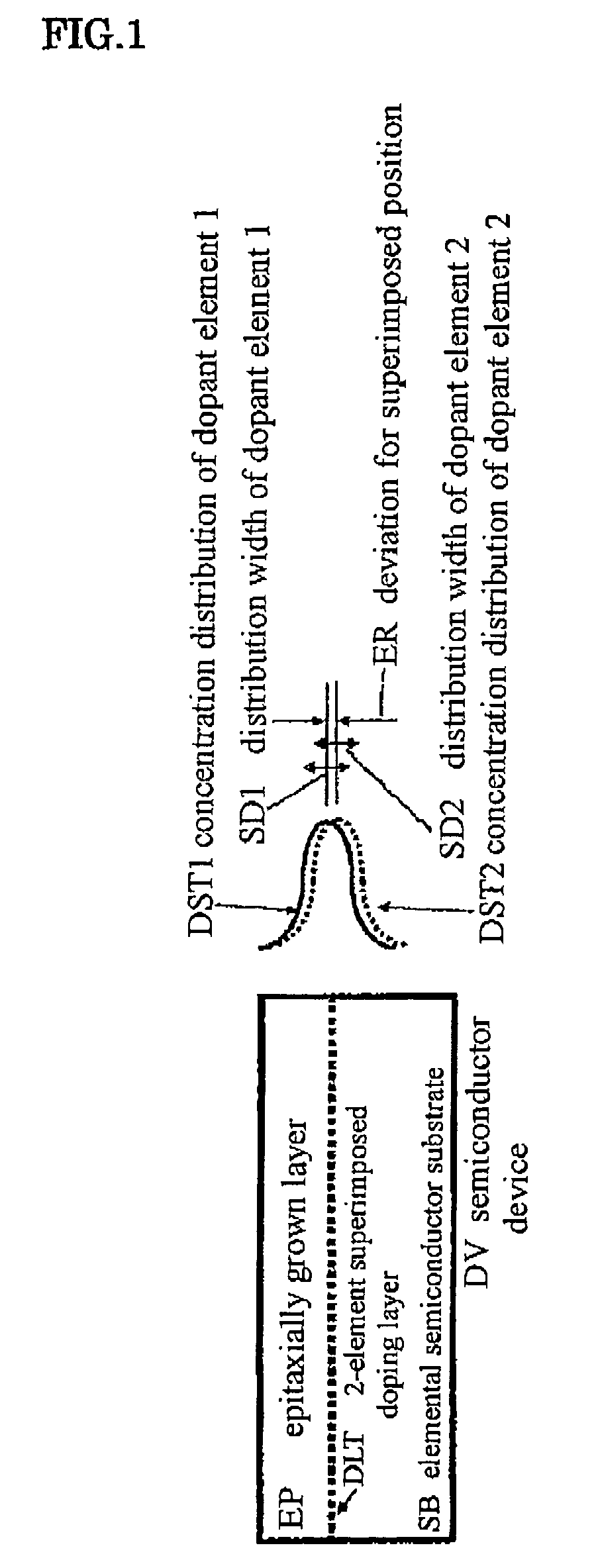Semiconductor and method for producing the same
a technology of semiconductors and semiconductors, applied in the direction of semiconductor devices, electrical devices, transistors, etc., can solve the problems of difficult -doping using a plurality of elements as dopants by solid phase epitaxy, and the difficulty of achieving the -doping technique itself, and achieve the effect of suppressing the segregation of doping on the surfa
- Summary
- Abstract
- Description
- Claims
- Application Information
AI Technical Summary
Benefits of technology
Problems solved by technology
Method used
Image
Examples
example 1
[0053]Description is to be made to a first example referring to FIG. 1 and FIG. 2. This example can include a silicon (001) crystal substrate as an elemental semiconductor substrate SB, a bismuth element as a first dopant element DP1, a bismuth thin line structure as a special surface structure SS of the first dopant element DP1, and an erbium element as the second dopant element DP2.
[0054]FIG. 3 shows the processing procedures of this example. Bismuth is vapor deposited at a substrate temperature T1 over a silicon (001) substrate to form the bismuth thin line structure. T1 is selected within a range of a temperature (500° C. to 600° C.) near the evaporation temperature of bismuth from above the silicon substrate. The time for forming the bismuth thin line structure is different depending on the temperature but there is no other differences. Successively, the temperature of the substrate is lowered to T2 to conduct deposition of erbium and deposition of silicon. In the case of this ...
example 2
[0072]Description is to be made for another example with reference to FIG. 1 and FIG. 2. This example can include a silicon (001) crystal substrate as an elemental semiconductor substrate SB, a bismuth element as a first dopant element DP1, a bismuth thin line structure as a special surface structure SS of the first dopant DP1, and an antimony element as a second dopant element DP2. The vapor deposition of antimony was conducted also at a substrate temperature T1 of 400° C. as in Example 1, and the total vapor deposition amount of antimony was defined as a 1-atomic layer. A report investigating the concentration distribution of the bismuth element and the antimony element in the state corresponding to FIG. 2(c) is described in the document: Bismuth and Antimony Nanoline in Si Epitaxial Layer. Microscopy of Semiconducting Materials 1999 (Edited by A G Cullis, and J. L. Hutchison, IOP Publishing Ltd., London), Inst. Phys. Conf. Ser. vol. 164 (1999), pp 167-170, K. Miki, H. Matsuhata, ...
example 3
[0073]Other example is shown in FIG. 13. The constitution is different from the examples described above in that the superimposed doping layer is formed repetitively. This is an effective means in a case of attaining a desired amount by repetition when the dopant amount of the superimposed doping layer is insufficient when applied for once, or intending to obtain doping at a certain concentration over a considerable thickness. The cross sectional shape of the obtained doping structure is shown in FIG. 12.
[0074]This example has one important feature as the doping technique. That is, the repetition of a plurality of doping can be simply realized by merely changing the substrate temperature and controlling the vapor deposition amount in this patent. This contrasts to the δ-doping method and the ion implantation technique as the prior method, which require serious procedures even for conducting doping only by once. Control can be attained by using those described in the example with ref...
PUM
 Login to View More
Login to View More Abstract
Description
Claims
Application Information
 Login to View More
Login to View More - R&D
- Intellectual Property
- Life Sciences
- Materials
- Tech Scout
- Unparalleled Data Quality
- Higher Quality Content
- 60% Fewer Hallucinations
Browse by: Latest US Patents, China's latest patents, Technical Efficacy Thesaurus, Application Domain, Technology Topic, Popular Technical Reports.
© 2025 PatSnap. All rights reserved.Legal|Privacy policy|Modern Slavery Act Transparency Statement|Sitemap|About US| Contact US: help@patsnap.com



